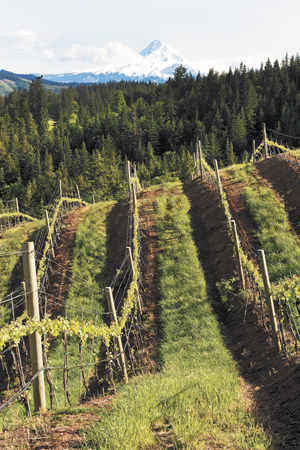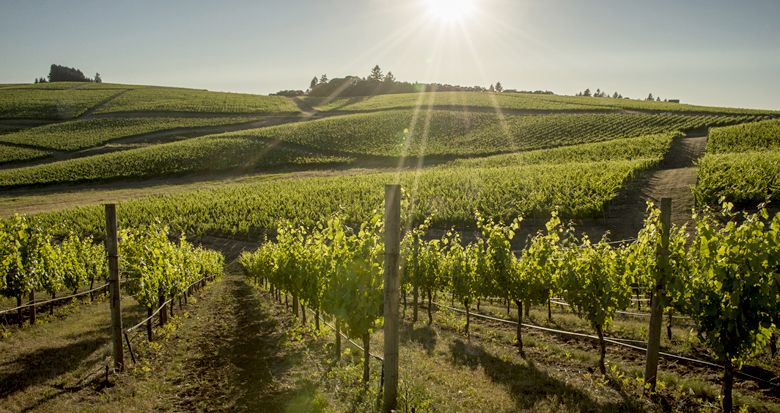A Place in the Sun
Bright future for wine country real estate
With an estimated $6 billion a year impact, the Oregon wine industry is about much more than glass pours and tasting rooms.
It’s become a multi-faceted organism encompassing farming, land-use policy, education, tourism, hospitality and more. Naturally, it’s also affected the real estate market, especially in recognized wine-growing zones.
Meri Kerekanich has worked 13 years for Kelly Group Real Estate in Newberg. She specializes in acreage properties such as farms and vineyards, many of which assume a commercial element once a brand or tasting room has been created. Her clients, from all over the country and beyond, feel drawn to the Willamette Valley’s beauty and exceptional quality of life.
“The biggest trend in real estate, in general, is its unpredictability,” she says. That doesn’t mean there aren’t trends. She’s witnessed a significant increase in California land buyers, drawn here by the relative affordability and lightened impact of serious events like drought and wildfire.
Recently, major industry names like The Family Coppola, Jackson Family Wines, Louis Jadot and Foley have made significant purchases in the Willamette Valley. Larger local players like Domaine Serene, Ponzi and Willamette Valley Vineyards have stretched their holdings, committed to staying in the game amid outside interest. Kerekanich says cannabis growers have been able to compete with winegrowers and winery owners when it comes to buying land.
How much is prime wine country land selling for these days? It depends.
“Prices differ tremendously with regard to vineyard-suitable land as well as already planted land, as quality, condition and utility are all considered,” Kerekanich says. The quality originates from location and AVA status, along with viticultural concerns like soil types, elevation, exposure and more. The condition element relates to the state of the buildings and the vineyard, including details like disease-resistant rootstock.

“Utility pertains to how functional the property is — if it has water rights, how many acres are plantable, the zoning, if it’s move-in ready,” she adds. Plantable land runs anywhere from $15,000 to $50,000 an acre, while planted land can fetch up to $100,000 an acre, according to Kerekanich. Two recent sales, located in esteemed AVAs (Ribbon Ridge and the Dundee Hills) cost $90,000 and $100,000 per acre.
“What I do know about the industry is that prices are all over the board,” she says. Many sellers do so privately, she says, often sealing transaction records. Kerekanich opts for land within the Valley’s sub-AVAs for obvious traffic and prestige reasons. Better deals often fall just beyond appellation boundaries.
Rita Wolff, an experienced broker for Keller Williams Realty, focuses increasingly on her wine country real estate project, Oregon Wine Country Properties. Last year, she worked most weekdays and weekends, trying to keep up with a phenomenal amount of interest.
Wolff says her buyers have been a mix of everything from individuals and small groups looking to own small slice of wine country to large Burgundian firms establishing large footholds or extending their acreage. Like Kerekanich, Wolff cites the attraction to the Willamette Valley in light of the looming costs and problems in places like California.
“Appraisals used to just be about the cost of land and the cost of improvement,” Wolff says. “Now it involves the type of dirt and whether you can get that type of dirt anywhere else.”
She points to elevation, soil type, neighborhood, wine scores and varieties the prospective buyer hopes to plant as several factors that can affect land prices. “It can vary so much, even within a single AVA,” she adds.
Established appellations like the Dundee Hills and Yamhill-Carlton may command high prices simply by association, but what’s available there is often limited compared to other areas. Wolff has seen increased interest in the Eola-Amity Hills and believes it’s only a matter of time until it becomes significantly more expensive. She says, “Watch, it’s going to explode.”
With more AVAs on the horizon, interest and reputation will likely only grow. But as one recent sale indicated, it doesn’t happen overnight. Wolff spent years working on a property in Junction City. The Lower Long Tom AVA, set in that southern stretch of the Willamette Valley, is not yet recognized. And even when it is, Wolff suggests, it’ll take a while for the reputation of the area to create a rise in land prices.
Wolff attributes at least some of her success to her familiarity with wine country. Her website spotlights the viticultural side of the properties, in a way that goes above and beyond the ubiquitous “vineyard potential” tag in most Willamette Valley listings. Vineyard-friendly properties tend to incorporate a report carried out by Results Partners that includes soil types, aspect details, drainage, microclimate info and more.
The prestige tied to the Willamette Valley name means the best bargains likely reside elsewhere. Vineyard land in the Columbia Gorge, the Rocks District and the Snake River Valley are relative frontiers compared to marquee names like Ribbon Ridge.
What about Southern Oregon?
According to Sky Blue Swain, an exclusive Oregon vineyard and winery broker for Keller Williams Southern Oregon Realty and founder of the Southern Oregon Wine Society, business is good. Excellent. She says buyers on her platform, vineyardsor.com, “are more plentiful now in the winter of 2019 than in any season in recent past.”
She continues, “Investors are more anxious to liquidate their assets in 2019 than in recent past years for the purpose of investing in real estate and, from my clients’ perspectives, vineyard real estate. The faltering stock market seems to be the strongest driving force behind today’s surge in vineyard seekers, whether it is a first-time lifestyle buyer or an existing wine company expansion.”
As for pricing, Swain says it is too complex to generalize. “The many variables, in regard to size of properties, quality of soil and overall terroir, make it difficult to pinpoint price ranges without specific parameters,” she explains. “But, I will say, Rouge Valley is seeing higher market prices than Umpqua Valley. I see both AVAs increasingly demand notably higher prices for vineyard potential land due to a simple formula called ‘supply and demand.’”
And interest remains high, with potential buyers from all over the world. “Seven out of 10 of my clients coming specifically to my website are in foreign countries, such as France, Italy, Australia, Dubai, Belgium, Kuwait, China, Argentina, Chile, Germany, Japan, U.K., India, etc. — some are ex-patriots with U.S. citizenship with no VISA issues,” Swain explains. “The balance being from California, Oregon, Washington, New York and many other states.”
Regardless where the client is from and where he or she lands here in Oregon, the days of aspiring young producers looking to plant a vineyard with a small loan and the money in their back pocket are mostly gone. The notable purchases of the last few years by large labels and out-of-state firms echo this sentiment. Perhaps the most relatable field, the economy itself, has become increasingly corporate and consolidated but not entirely unapproachable.










